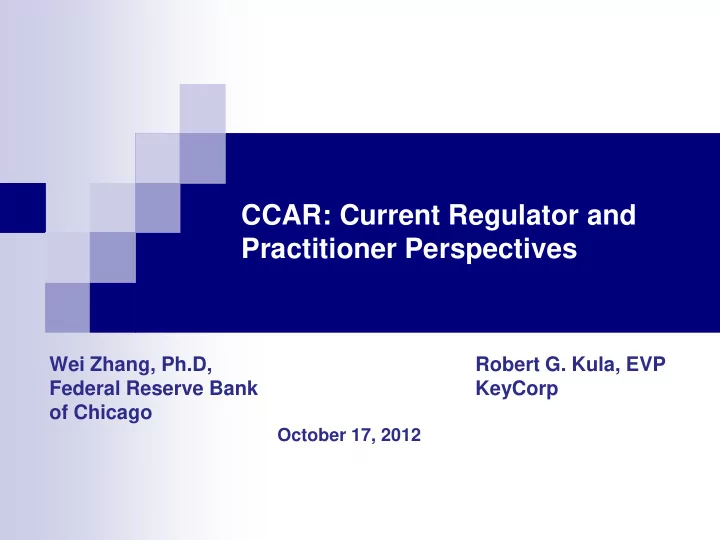

CCAR: Current Regulator and Practitioner Perspectives Wei Zhang, Ph.D, Robert G. Kula, EVP Federal Reserve Bank KeyCorp of Chicago October 17, 2012
Disclaimer The views expressed in this presentation are the authors’, and do not necessarily represent those of The Federal Reserve Bank of Chicago, or The Federal Reserve System, or Key Corp. 2
Comprehensive Capital Analysis and Review The initial Federal Reserve System CCAR exercise was initiated in December 2010 and executed in early 2011 Had its roots in the 2009 Supervisory Capital Assessment Program (SCAP) exercise CCAR 2, or CCAR 2012, encompassed the same 19 large banks as the first CCAR and original SCAP Entailed submitting a detailed capital plan and extensive data schedules Four scenarios: BHC-specific base and adverse scenarios, and supervisory base and adverse scenarios developed by the Federal Reserve 3
Supervisory Review of Capital Plan Comprehensiveness of the capital plan Reasonableness of the BHC’s assumptions and analysis Robustness of capital adequacy process BHC’s capital policy BHC’s ability to maintain capital above regulatory minimums 4
Supervisory Expectations for a Capital Adequacy Process: Seven Principles 1. Foundational Risk Management 2. Loss Estimation Methodologies 3. Capital Resource Estimation Methodologies 4. Assessing Capital Adequacy 5. Capital Planning & Capital Decisions 6. Internal Controls 7. Governance 5
Principle 1: A BHC should have a sound risk management infrastructure that supports the identification, measurement, and assessment of all material risks arising from its exposure and business activities . BHC focus/challenges: Major Points: Definition of materiality Risk identification process Granular, loan level models Comprehensive Expert judgment Risk measurement / assessment Hard to quantify risks Complete, accurate Roles of functional groups, risk committees, and the Data sufficiency / quality Board Internal controls / data Connecting the outputs from integrity process various models 6
Principle 2: A BHC should have effective processes for translating risk measurements into estimates of potential losses over a range of adverse scenarios and environments and for aggregating those estimated losses across the BHC. BHC focus/challenges: Major Points: All material risks and their Tailored to bank exposures interplay and business activities Consistent process across all Loss forecasts for all scenarios – starting with the material risk exposures fact set (model output) Translation of scenarios Models sensitive to macro economic factors Transparency / documentation of limitations Understanding model limitations Application of judgment to Sound expert judgment that risk measures & loss can be quantified and modeling reconciled 7
Principle 3: A BHC should have a clear definition of available capital resources and an effective process for forecasting available capital resources (including any forecasted revenues) over the same range of adverse scenarios and environments used for loss forecasting. Major Points: BHC focus/challenges: Modeling PPNR Considering path of capital resources over time Model documentation Current portfolio mix vs. Both “sources” and “uses” future of Capital Transparency / support for Absorption of losses in the management judgment Base case vs. a Stress Consistency Risks not material in a Base case may be material in a with balance sheet Stress assumptions across business units 8
Principle 4: A BHC should have processes for considering the impact of loss and resource estimates on capital adequacy, in line with the BHC’s stated goals for the level and composition of capital, which take into account any limitations of the BHC’s capital adequacy process. BHC focus/challenges: Major Points: Capital policy Capital adequacy metrics Capital buffers Supplementary measures/analysis Understanding limitations to the process Consideration of limitations / weaknesses Reverse stress testing Capital buffer components Accuracy vs. conservatism Governance/audit to ensure Bank’s models vs. the accountability Federal Reserve’s models 9
Principle 5: A BHC should have a process, supported by its capital policy, to use its assessments of the impact of loss and resource estimates on capital adequacy to make decisions regarding the current level and composition of capital, specific capital actions, and capital contingency plans. BHC focus/challenges: Major Points: Robust capital policy Comprehensive capital policy framework Detailed CCAR submission – the capital plan and Clearly articulated capital supporting materials goals and triggers/events that drive reconsideration of Base case and Stress results capital levels, distribution with and without proposed levels or other contingent capital actions actions Contingency activities Capital contingency plan 10
Principle 6: A BHC should have robust internal controls governing its capital adequacy process components, including sufficient documentation, change control, model validation and independent review, and audit testing. BHC focus/challenges: Major Points: Change Control Procedures Documentation for CAP Procedures for making Model risk / validation qualitative adjustments to Robust MIS model output Audit review Model Risk Control – independent model validations Documenting what you did and what you thought Role of Risk Review/Audit 11
Principle 7: A BHC should have effective board and senior management oversight of the CAP, including periodic review of capital goals, assessment of the appropriateness of adverse scenarios considered in capital planning, regular review of any limitations and uncertainties in the process, and approval of planned capital actions. BHC focus/challenges: Major Points: Credible challenge Board of directors oversight Understanding limitations Senior management responsibilities Escalation procedures Functional vs. Governance activities Day to day management vs. Oversight Formal approval process 12
Questions? 13
Recommend
More recommend